
Cambarus is a large and diverse genus of crayfish from the United States and Canada. The adults range in size from about 5 cm (2.0 in) up to approximately 15 cm (5.9 in).
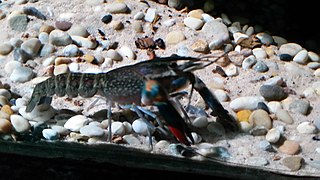
The Everglades crayfish, sometimes called the Florida crayfish, the blue crayfish, the electric blue crayfish, or the sapphire crayfish, is a species of freshwater crayfish endemic to Florida in the United States. Its natural range is the area east of St. Johns River and all of Florida from Levy County and Marion County southwards, as well as on some of the Florida Keys. It is included on the IUCN Red List as a species of Least Concern. The blue crayfish is frequently kept in freshwater aquaria. In the wild, this species varies from brown-tan to blue, but an aquarium strain has been selectively bred to achieve a brilliant cobalt blue color.
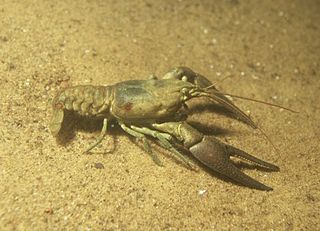
Cambarus aculabrum is a rare species of cave-dwelling crayfish known by the common name Benton county cave crayfish. It is native to Arkansas in the United States, where it is known from only four locations. It is a federally listed endangered species of the United States.

Cambarus cryptodytes, the Dougherty Plain cave crayfish or Apalachicola cave crayfish, is a small, freshwater crayfish endemic to Florida and Georgia in the United States. It is an underground species known only from waters associated with the Floridan aquifer.
Cambarus deweesae, the valley flame crayfish, is a species of crayfish in the family Cambaridae. It is found in Kentucky and Tennessee.
Cambarus elkensis, the Elk River crayfish, is a species of crayfish in the family Cambaridae. It is found in North America.
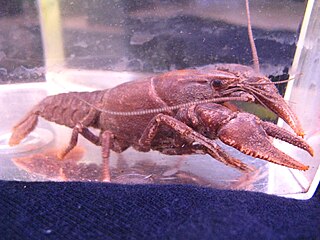
Cambarus georgiae, the Little Tennessee crayfish, is a species of crayfish in the family Cambaridae. It is found in Georgia and North Carolina.
Cambarus nerterius, the Greenbrier cave crayfish, is a species of crayfish in the family Cambaridae. It is endemic to the state of West Virginia in the United States. It is found only in or immediately adjacent to caves in Greenbrier and Pocahontas counties, and is included on the IUCN Red List as a Near Threatened species.
Cambarus subterraneus, the Delaware County cave crayfish, is a species of crayfish in the family Cambaridae. It has been found only in three caves in Delaware County, Oklahoma.
Cambarus tartarus, the Oklahoma cave crayfish, is a species of crayfish in the family Cambaridae. It is endemic to two caves in Delaware County, Oklahoma in the United States.
Cambarus truncatus, the Oconee burrowing crayfish, is a species of crayfish in the family Cambaridae. It is found in North America.
The Guyandotte River crayfish is a species of crayfish found in a small stream system in Wyoming County, West Virginia, USA. They are closely related to the Big Sandy crayfish, and until recently, the two were thought to belong to the same species. The Guyandotte River Crayfish is currently listed as Data Deficient by the IUCN and was listed under the Endangered Species Act with the Big Sandy Crayfish on April 4th, 2016.
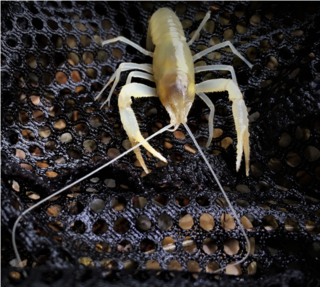
Cambarus zophonastes, also known as the Hell Creek Cave Crayfish, is named for its original location of discovery, Hell Creek Cave. It is also found in other similar habitats in Stone County and Marion County, Arkansas. These habitats include springs and caves such as Nesbitt Spring Cave in Stone County. C. zophanastes is critically endangered according to the IUCN. C. zophanastes is also protected by the ESA as an endangered species. Currently conservation efforts focus on monitoring populations, reducing disturbances, and monitoring water quality. More research has to be conducted to better understand and conserve the species.
Cambarus pecki, sometimes called the phantom cave crayfish, is a species of crayfish in the family Cambaridae. It is endemic to Alabama where it is found in three unconnected caves in the Tennessee River drainage in Colbert County, Lauderdale County, and Morgan County.
Devils Well is a sinkhole cave near Akers in the U.S. state of Missouri, containing an underground lake that is the largest in the state. It is a part of the Ozark National Scenic Riverways and can be viewed by the public any day during daylight hours. The U.S. Park Service has set up a metal staircase and a switch-activated light; however, it is recommended that visitors bring additional light sources.
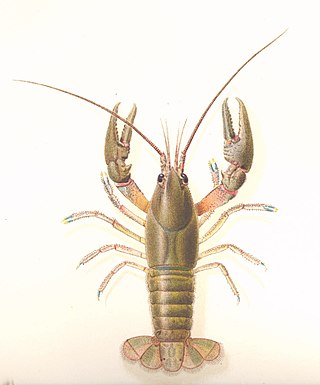
Cambarus robustus, known generally as the robust crayfish or Big Water crayfish, is a species of crayfish in the family Cambaridae. It is found in North America.
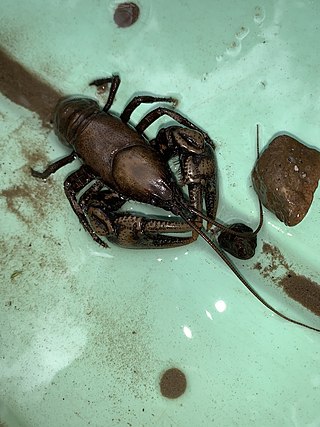
Cambarus carinirostris, the rock crayfish, is a species of crayfish in the family Cambaridae. It is found in the mid-Atlantic region of the United States.
Cambarus setosus, the bristly cave crayfish, is a freshwater crayfish native to Missouri and Arkansas in the United States. It is a cave-dwelling species known from 164 localities with the majority on the Springfield Plateau in southwestern Missouri.
Cambarus veitchorum, the White Spring cave crayfish, is a small, freshwater crayfish endemic to Limestone County, Alabama in the United States. It is a cave-dwelling species known from only one cave, the White Spring Cave.








